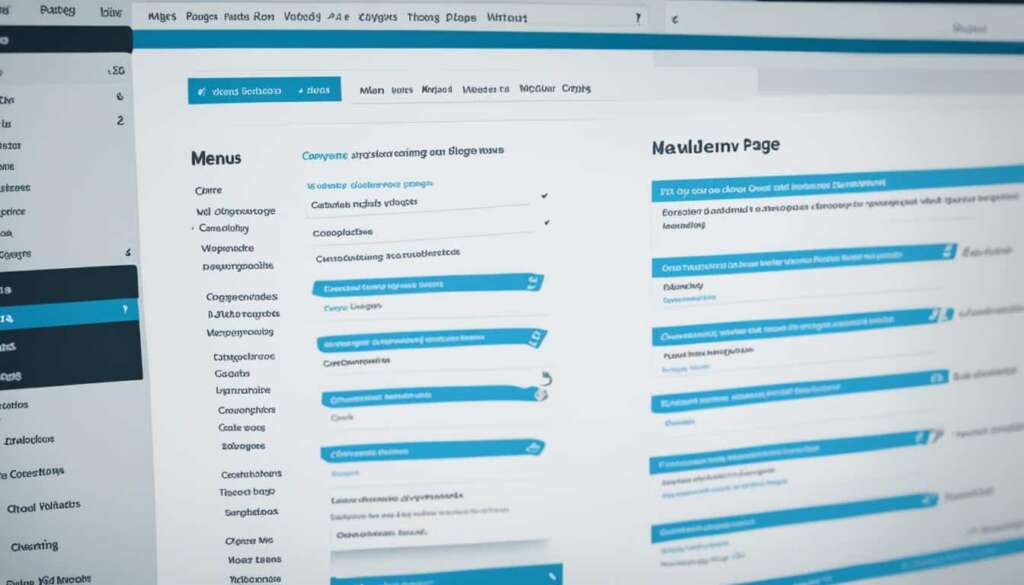Table of Contents
In this comprehensive guide, we will walk you through the process of editing menus in WordPress. Menu customisation plays a vital role in enhancing user experience and optimising your website’s navigation. By following these steps, you’ll be able to create a seamless and user-friendly menu structure for your WordPress site.
Key Takeaways:
- Menu customisation is crucial for improving user experience and site navigation in WordPress.
- Access the menu editor through the “Appearance” section in the WordPress admin panel.
- You can add, remove, and reorder menu items effortlessly in the menu editor.
- Customise menu labels and attributes to create a more descriptive and user-friendly navigation experience.
- Submenus and mega menus are effective ways to organise and structure your WordPress menu.
Understanding WordPress Menus and their Importance
Before diving into editing menus, it’s crucial to understand the purpose and importance of WordPress menus. They serve as the primary navigation tool for users, allowing them to navigate through different sections of your website. A well-structured menu enhances user experience, improves site accessibility, and boosts SEO performance.
WordPress menu structure plays a key role in organizing your website’s content and guiding user navigation. By strategically arranging menu items, you can create a logical and intuitive browsing experience. This not only helps visitors find the information they need quickly but also encourages them to explore your site further.
Menu functionality goes beyond basic navigation. With WordPress menus, you can incorporate various features and capabilities to enhance user engagement. This includes dropdown menus, submenus, and mega menus, which provide additional layers of hierarchy to accommodate a larger volume of content without overwhelming the user.
Benefits of a Well-Structured WordPress Menu:
- Improved user navigation and accessibility
- Enhanced user experience, reducing bounce rates
- Efficient content organization and categorization
- Increased time spent on your website
- Better SEO performance and site visibility
“A well-designed menu provides users with a clear roadmap to explore your website, making it easier for them to find the information or products they’re looking for.” – Website UX Expert
By optimizing your WordPress menu, you can guide visitors towards desired actions, such as making a purchase, subscribing to a newsletter, or contacting you. This not only improves conversion rates but also strengthens your overall website performance.
Furthermore, a well-structured menu ensures that all website sections receive appropriate visibility, preventing important pages from being buried deep within your site’s hierarchy. This is particularly important for SEO, as search engines prioritize websites with well-organized navigation structures.
With the understanding of WordPress menu importance, let’s explore how to access and edit menus in the following section.
Accessing the Menu Editor in WordPress
To edit menus in WordPress, you need to access the menu editor. Follow these simple steps to navigate to the menu editor in your WordPress admin panel:
- Login to your WordPress Admin Panel: Open your web browser and enter the URL of your WordPress website. Append “/wp-admin” to the end of the URL (e.g., yourwebsite.com/wp-admin) and press Enter. Enter your login credentials and click on the “Log In” button to access your WordPress admin panel.
- Navigate to the “Appearance” Section: Once you’re logged in, you will see the WordPress admin dashboard. In the left-hand sidebar, locate and click on the “Appearance” tab. This will expand the menu options under “Appearance”.
- Click on “Menus”: Within the “Appearance” section, you will find the “Menus” option. Click on “Menus” to open the menu editor.
By accessing the menu editor, you gain complete control over your website’s navigation and can make changes to your menus as desired.
Here is an image to illustrate the process:
Adding, Removing, and Reordering Menu Items
Once you’re in the menu editor, you have complete control over adding, removing, and reordering menu items in WordPress. These actions allow you to customize the menu structure to best suit your website’s needs and improve user navigation.
Adding Menu Items
Adding menu items in WordPress is a simple process. To begin, select a page, post, or custom link from the left-hand menu options in the editor. Once you’ve chosen the desired item, click on the “Add to Menu” button to include it in your menu.
By following these steps, you can easily add relevant pages or links to your menu, ensuring that visitors can access important content with just a click. This also provides a seamless navigation experience and makes it easier for users to find what they’re looking for on your website.
Removing Menu Items
If you need to remove a menu item from your WordPress menu, the process is straightforward. Simply click on the arrow icon next to the specific item you wish to remove. Then, select the “Remove” option from the dropdown menu.
Removing unnecessary menu items helps declutter your navigation and ensures that only the most relevant and important content is displayed. By streamlining your menu, you can enhance user experience and guide visitors to the key areas of your website.
Reordering Menu Items
Reordering menu items is an effective way to prioritize specific content in your WordPress menu. With the drag and drop functionality in the menu editor, you can easily change the position of menu items.
To reorder your menu items, simply click on a menu item and hold the left mouse button. Then, drag the item to your desired position within the menu. Release the mouse button to drop the item into its new place.
By reordering menu items, you can ensure that the most important sections of your website are prominently displayed and easily accessible within the menu hierarchy. This allows users to navigate through your website more efficiently and find the content they need with ease.

| Action | Method |
|---|---|
| Adding a menu item | Select the page, post, or custom link from the left-hand menu options and click “Add to Menu”. |
| Removing a menu item | Click the arrow icon next to the item and select “Remove”. |
| Reordering menu items | Drag and drop the menu items to the desired position. |
Customizing Menu Labels and Attributes
Customizing menu labels and attributes is an essential aspect of creating a more descriptive and user-friendly navigation experience for your WordPress site. Through the menu editor, you have the flexibility to change the label of each menu item according to the desired text you want to display.
For example, if your website offers various product categories, you can customize the menu label from “Shop” to “Products” to provide clarity and better reflect your offerings.
In addition to customizing menu labels, you can also enhance the usability of your menu by adding descriptions to menu items. These descriptions can offer valuable information or additional context about the particular page or section linked to the menu item.
Suppose you have a menu item titled “About Us.” By adding a brief description such as “Learn more about our company’s values and history,” you provide users with a glimpse of what they can expect when they visit the About Us page.
By customizing menu labels and attributes, you can guide users through your website more effectively and provide them with the necessary information to make informed decisions. This ultimately contributes to a better user experience and engagement on your WordPress site.
Example: Customized Menu Label and Description
| Menu Item | Label | Description |
|---|---|---|
| Home | Discover | Start your journey here with our latest content and updates. |
| Blog | Insights | Explore insightful articles and expert opinions on various topics. |
| Shop | Products | Discover our wide range of high-quality products for every need. |
| About | Story | Get to know our company’s mission, values, and history. |
By referring to the example above, you can see how customizing menu labels and adding descriptions can significantly improve the clarity and relevance of your website navigation. Take the time to assess your menu structure and make the necessary adjustments to create a seamless browsing experience for your visitors.
Submenus and mega menus are powerful tools for organizing and structuring your WordPress menu. They allow you to create dropdown menus that improve the user experience and make it easier for visitors to navigate your website. Here’s how you can create submenus and mega menus in WordPress:
To create a submenu, you simply need to indent a menu item below another item. When the parent item is hovered over, the submenu will appear as a dropdown, providing additional navigation options. Submenus help to categorize and organize menu items, enabling users to access specific sections of your website easily.
Let’s take a look at an example:
| Main Menu | Submenu |
|---|---|
| About Us | – Mission and Vision |
In the example above, “About Us” is the main menu item, and “Mission and Vision” is the submenu item that appears when “About Us” is hovered over. This allows you to provide more detailed information or additional options related to the main menu item.
Utilizing Mega Menu Plugins
If you want to create more advanced and visually appealing dropdown menus, you can utilize mega menu plugins. These plugins offer extensive customization options and features that allow you to design feature-rich mega menus that seamlessly integrate into your WordPress site.
In the example above, the mega menu includes multiple columns with different content and navigation options. This can be particularly useful for websites with a large number of pages or complex navigation structures.
By using mega menu plugins, you can unleash your creativity and create stunning dropdown menus that enhance user experience, improve navigation, and showcase your website’s content effectively.
Keep in mind that different plugins may have different methods of creating and customizing mega menus. Make sure to choose a plugin that suits your needs and offers the flexibility to design menus that align with your website’s brand and aesthetic.
Now that you understand how to create submenus and utilize mega menu plugins, you can take your WordPress menu customization to the next level. Experiment with different menu structures, optimize your navigation, and provide a seamless browsing experience for your website visitors.
Enhancing Menus with Plugins and Themes
WordPress offers a wide range of plugins and themes that can take your menus to the next level. By incorporating menu plugins and customizing themes, you can enhance both the functionality and appearance of your website’s menu. These enhancements not only improve user experience but also provide advanced menu features to optimize navigation.
Plugins for Advanced Menu Functionality
To add advanced features to your menus, consider installing WordPress menu plugins. These plugins offer a variety of functionalities that can elevate your menu design:
- Add icons: With menu icon plugins, you can incorporate visually appealing icons into your menu items, making them more intuitive and engaging.
- Animations: Animated menu plugins allow you to add dynamic animations, such as fade-ins or slide-outs, to provide a modern and interactive menu experience.
- Dynamic content: Some plugins enable you to include dynamic content within your menus, such as displaying the latest blog posts or showcasing featured products.
By leveraging the power of menu plugins, you can transform your menu into a highly functional and visually appealing navigation tool.
Customizing Menu Appearance with Themes
In addition to plugins, WordPress themes play a crucial role in menu customization. Many themes offer pre-designed menu layouts that can be easily tailored to match your website’s design and branding. By selecting a theme with built-in menu customization options, you can effortlessly modify the appearance of your menu without diving into complex coding.
“Using a theme designed specifically for menu customization can save you time and effort, allowing you to focus on other aspects of your website.”
These themes often provide options to customize menu fonts, colors, sizes, and spacing, ensuring a seamless integration with your overall website design. Whether you prefer a classic, minimalist menu or a vibrant, eye-catching design, there’s a WordPress theme to match every aesthetic preference.
| Advantages of Plugins and Themes for Menu Enhancement | Plugins | Themes |
|---|---|---|
| Enhanced functionality | Ability to add icons, animations, and dynamic content | Pre-designed menu layouts tailored to your website’s design |
| Easy customization | User-friendly interface for adding and configuring advanced menu features | Options to modify menu fonts, colors, sizes, and spacing |
| Time-saving | Quick installation and setup process | Effortless customization without complex coding |
Table: Advantages of Plugins and Themes for Menu Enhancement
By leveraging both plugins and themes, you can unlock the full potential of your WordPress menu. By adding advanced functionality and customizing the appearance, you can create a seamless and intuitive navigation experience that aligns with your website goals and brand identity.
Conclusion
In conclusion, editing menus in WordPress is essential for optimizing user experience and site navigation. By following the step-by-step guide provided, you can create a well-structured and intuitive menu that improves usability and engagement on your website. Customizing your menus, experimenting with different designs, and ensuring they align with your overall website goals are crucial for success.
Remember, a well-designed menu enhances user satisfaction, simplifies navigation, and contributes to better SEO performance. With WordPress’s user-friendly menu editor, you have the flexibility to add, remove, and reorder menu items effortlessly. Additionally, you can customize menu labels, attributes, and even create submenus or mega menus to further organize your content.
Furthermore, WordPress offers a variety of menu plugins and themes that can elevate your menu’s functionality and appearance. Whether you want to add dynamic content, icons, or animations, or choose from pre-designed menu layouts, these resources ensure you can achieve the desired look and user experience.
So, take advantage of WordPress’s powerful menu editing capabilities and create a seamless and user-friendly menu that enhances your website’s navigation. Happy menu editing!
FAQ
To edit menus in WordPress, you need to access the menu editor. Log in to your WordPress admin panel and navigate to the “Appearance” section in the sidebar. Click on “Menus” to open the menu editor, where you can make changes to your website’s navigation.
WordPress menus play a crucial role in website navigation. They serve as the primary tool for users to navigate through different sections of your website. A well-structured menu enhances user experience, improves site accessibility, and boosts SEO performance.
In the menu editor, you can add menu items by selecting a page, post, or custom link from the left-hand menu options and clicking on the “Add to Menu” button. To remove a menu item, click on the arrow icon next to the item and select “Remove.” To reorder menu items, simply drag and drop them into the desired position.
Yes, you can customize menu labels and attributes in WordPress. In the menu editor, you have the option to change the label of each menu item to reflect your desired text. Additionally, you can add descriptions to menu items, providing additional context or information to users.
To create a submenu in WordPress, indent a menu item below another item in the menu editor. It will appear as a dropdown when the parent item is hovered over. For more advanced menu designs, you can use mega menu plugins to create visually appealing and feature-rich dropdown menus.
Absolutely! WordPress offers a wide range of plugins and themes that can enhance your menus’ functionality and appearance. By installing menu plugins, you can add advanced features like icons, animations, or dynamic content. Some themes also provide pre-designed menu layouts that can be easily customized to match your website’s design and branding.
Yes, menu editing in WordPress is important for optimizing user experience and site navigation. A well-structured and intuitive menu improves website usability and engagement. Take the time to customize your menus, experiment with different designs, and ensure they align with your overall website goals.












